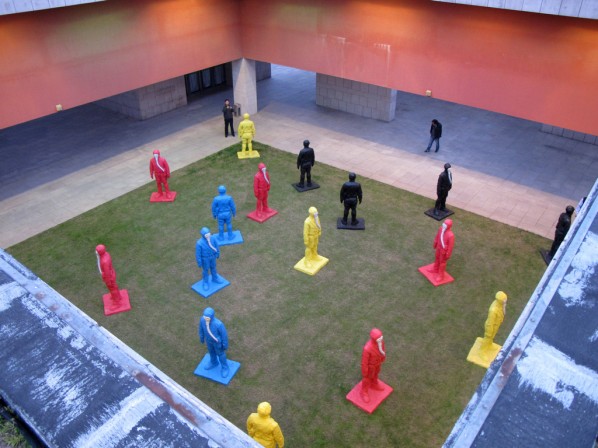
Wang Guangyi has always held a special position in Chinese contemporary art, one which is comprised of his inherent contradictory structure. Though those "great criticism" art works will never again provide us with a visual shock, we cannot deny that these images-- more accurately, his handling of the images--once precisely disseminated all of the contradictory experiences we were having at the time: from indescribable belief to angry deconstruction, from the mettle of heroism to the fashionable pandering of consumerism, from grave criticism of international political relations to nationalist catharsis...he reveled in continuously creating visual suspense, but before we had time to guess the answer to the riddle, he would destroy it. In terms of art history, he counts as an artist who is full of power yet remains unfathomable.
[gallery link="file" orderby="title"]
Cold War AestheticsAs one of the most challenging contemporary artists in China, Wang Guangyi seems to make a move in every junction of art history, from the "rational painting" of the arctic period to the analytics of the post classical period, from "clearing out the humanist passions" to Great Criticism, from research of Eastern and Western political systems to reshaping the visual mythology of local materialism...it is in this "endlessly questioning" art history practice that he has gradually formed a unique visual political science. In this political science, instead of saying that the historical and political resources are the matrix for expressing set political concepts, it would be more accurate to say that they are a kind of visual strategy and dialectic wittiness. He has always maintained a careful "neutral" attitude towards history and politics, and does not make value judgments lightly. With a lofty gaming attitude he allows those highly solemn political topics to maintain a kind of sublimity. On this matter he is very close to Beuy's attitude towards politics:" he does not care about the art of politics, only about the politics of art. "It is the unity between this transcendence and gamely feels that makes his role in Chinese contemporary art more like that of a historical soothsayer than a pure critic. Perhaps it is only because of this that he is considered by critics to be an artist who embodies the qualities of both Beuys and Warhol.
In 2007, Wang Guangyi played another card from his visual political science, Cold War Aesthetics. This giant visual project also made use of dual historical and political resources. With an event of nationwide civilian military preparedness from the height of the Cold War in the '60's as the backdrop, it unfolds his visual illusions about the real world. The "three defenses" (defending against atomic, chemical and biological weapons) was a national defense education movement that took place in the 1960s when Sino-Soviet relations were at their worst. It has virtually all of the political traits of the Cold War: a highly specific hypothetical enemy, a high level of ideology and a high level of pertinence to the entire populace. Compared to the "internal revolution" of the Cultural Revolution that was taking place at the same time, it is more marked by peculiarly international traits. It is obvious that just like Great Criticism, with its usage of political image resources; Cold War Aesthetics is not about dredging up our visual memories of this movement but about proving reality. Here is how the artist describes his project:
The Cold War has a brutal side, which was of course imagined. It also has a game side to it. At the same time, it influenced our view of the world. To this day we still look at the world with a Cold War mentality. Today's political state of affairs is the fruit of seeds planted during the Cold War; it is the same with 9-11, the same with Al-Qaeda. These are all different means of expression from the Cold War.
The Cold War is a political heritage that had been left to mankind by the 20th century. It wasn't a "conclusion of history" but a new seed that was planted into human history. The Korean War, the Vietnam War, nuclear testing, China's Cultural Revolution, the 1968 uprisings across Europe, the Beatles and the Rock movement, the space race... all of these real historical spectacles are not only influencing our psychological orientation and cultural personalities, they are also influencing the future direction of the world. In this sense, Cold War Aesthetics is a visual prophecy provided to the world's new history by a Chinese artist.
Quoted from "Visual Political Science: Another Wang Guangyi" by Huang Zhuan
Translated by Jeff Crosby




























